The most durable 1.5 volt batteries. Are the advertised Duracell and Energizer so good?
Modern devices, be it a remote control for household appliances, a portable appliance or a children's toy, cannot be imagined without the use of batteries. But, despite the wealth of choice, few people know what kind of batteries there are, how long they last, and which ones retain their charge for the longest possible time.
What are batteries
- Salt. The service life is short. Rapid loss of charge. They are marked with the letter R.
- Alkaline (alkaline). You can distinguish it by the inscription Alkaline on the case. Compared to salt water, they have better quality and a longer service life. When marking such batteries, the letters LR are used.
- Mercury. As the name suggests, they are filled with mercury oxide. The shelf life is quite large, as are the size of the batteries. Not widely spread.
- Lithium. Lithium, which is part of the batteries, retains the highest voltage at a small size. Therefore, this type of battery lasts longer than others, retains a charge for a significant period and can withstand significant temperature changes.
Device types
If you are thinking about how best to choose a battery for the device, then its choice directly depends on the device in which you intend to install it.
According to the amount of energy consumption, devices are divided into groups:
- Low energy consumption - clocks, remotes, etc. The cheapest salt batteries are suitable for them, as their power is enough to ensure the operation of these devices for 12-16 months.
- Medium consumption - digital equipment - radios, audio players, PDAs, etc. One set of alkaline batteries ensures the operation of such devices for 15-20 hours.
- Intensive consumption - lanterns of sufficiently high power, toys, etc.
- Digital cameras. They consume energy not constantly, in short powerful jerks (flash power). Therefore, they require special batteries that have big power charge and the ability to quickly recover.
When you have settled on which battery to choose, pay attention to the labels on the batteries. Almost all manufacturers began to indicate in which area their products can be used with the greatest effect. Conducted studies and tests have shown that these recommendations should be trusted. Usually manufacturers of mechanisms for which batteries are needed indicate which batteries to choose.
Batteries
If the difficulty of choice lies in how to choose rechargeable batteries, which serve longer than usual, then they are of the following types:
- Alkaline (RAM) - their price is low, as is the service life (within 50 recharges). Do not withstand negative temperatures.
- Lead-acid (SLA) - good where more power is required and the dimensions of the battery do not create problems. The disadvantages include a long charging time and failure in the event of deep discharge. AT various conditions can withstand up to 600 charges.
- Nickel-cadmium (NiCd) - provide high current and can withstand a short circuit. Withstand temperature difference from -40° to +50°C, fast charge, designed for more than 1000 charge cycles.
- Nickel-metal hydride (NiMH) - their advantages are not as great as the disadvantages - about 500 cycles, long charging time, high price.
- Lithium-ion (Li-Ion) - the specific capacity is higher than that of all the others, the lowest self-discharge, the service life is up to 10 years. The number of cycles is more than 1000. The disadvantages include high cost.
- Lithium-polymer (Li-Pol, Li-Polymer) - currently quite expensive and short-lived.
- Lithium (Li-Metal) - rarely used and in certain devices.
Now it's easy to determine which batteries are best and purchase the ones that best suit your needs.
The most popular are batteries manufactured under the Duracell brand, Varta, Energizer and Maxell are no less popular. The most affordable are Panasonic, GP, Sony and others.
Every time you buy batteries or accumulators, there are many questions:
- How expensive batteries and accumulators are better than cheap ones?
- How much larger are lithium batteries than regular batteries?
- How much capacity of saline batteries is less than that of alkaline?
- Are batteries different for digital devices from ordinary?
- Which of the batteries and accumulators that cost the same is better to buy?
To get answers to these questions, the author of this study, Alexei Nadezhin, tested all AA and AAA batteries and accumulators that he could reach. As a result, 58 types of AA batteries and 35 types of AAA batteries, 44 AA batteries and 35 AAA batteries participated in the testing. A total of 255 batteries and 198 rechargeable batteries were tested. So, the selection turned out to be more than decent.
Conclusions for the buyer on batteries
- Most alkaline batteries differ in capacity by only 15%;
- It is most profitable to buy batteries from Auchan and Ikea brands. These will be the best AA or AAA batteries in terms of price / quality ratio, suitable for cameras, flashlights and any other application;
- In other stores, you can safely buy the cheapest alkaline batteries (they are also called alkaline), because you will not notice much difference.
- From what is sold in supermarkets, the best choice is GP Super;
- Lithium batteries are expensive, but they are light, capacious and can work in the cold.
- Salt batteries are not worth buying. Even in devices with the smallest consumption, alkaline (Alkaline) will last much longer due to their long shelf life;
- The capacity of AAA batteries is almost three times less than that of AA.
Battery Conclusions
- Ikea batteries are the best here too. If Ikea is not in your city, the legendary Panasonic Eneloop or Fujitsu are a good option. In fact, all three brands are produced at the same plant and using the same technology. Therefore, it is worth buying those that are cheaper.
- The maximum real capacity for AA NiMh batteries is 2550 mAh, for AAA - 1060 mAh. All batteries that say 2600, 2700, 2800 mAh and more actually have a lower capacity.
- NiMh batteries, unlike batteries, almost do not reduce the amount of energy output at high discharge currents. Therefore, if you need a battery for a flash or a remote control model, it is better to use a battery.
- For a month of storage, both conventional and LSD batteries lose 4-20% of their charge. Batteries similar to them are best driven by Ikae
- New LSD batteries are usually 70% charged.
Why should you believe this article?
This material is a brief excerpt from a large study by Alexei Nadezhin, which he wrote for more than a year (see the grandiosebattery testing and batteries ). These studies are so extensive that we do not know of any other such source in Russia or abroad. So yes, this article can be trusted. And yes, you can choose good batteries.
Grand testing of AA and AAA batteries
During the study, Alexey tested 255 batteries. During testing
three main modes were used:
- Discharge with direct current 200 mA. Such a load is typical for electronic toys;
- Discharge with 1000 mA pulses (10 seconds load, 10 seconds pause). This load is typical for digital devices;
- Discharge with 2500 mA pulses (10 seconds load, 20 seconds pause). Such a load is typical for powerful digital devices - cameras, flashes.
The graph below clearly shows how different types of batteries behave:
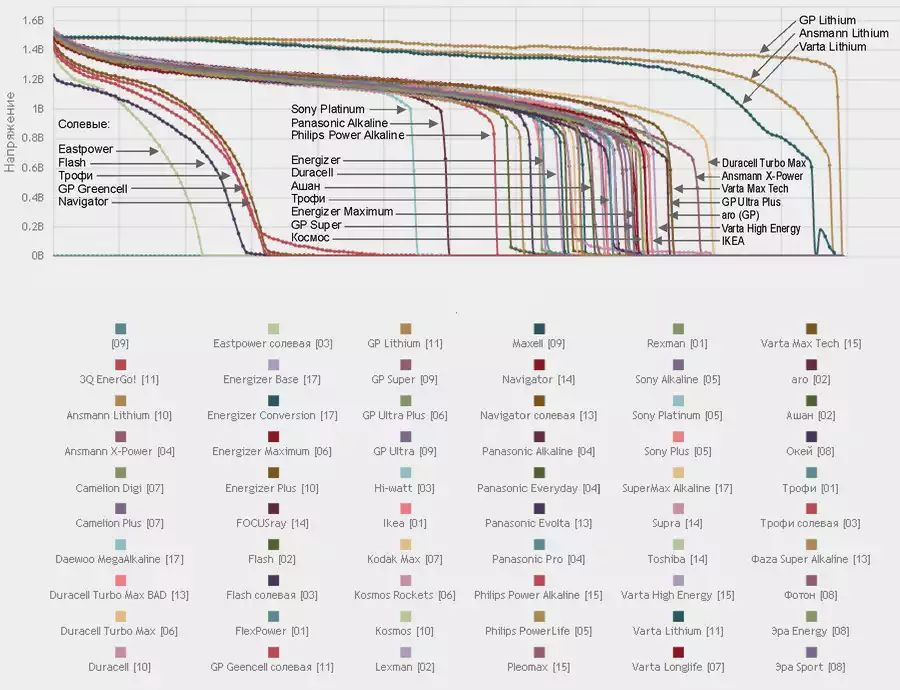
The first five lines are how salt batteries behave. It is clearly seen how much smaller their capacity is. The last three lines are lithium batteries. They not only have a large capacity, but they also discharge differently: the voltage on them does not decrease almost to the very end, and then drops sharply. This is especially pronounced in the GP Lithium battery. In addition, lithium batteries can work in the cold.
Among the many similar alkaline batteries, two outsiders are clearly visible - Sony Platinum and Panasonic Alkaline and two leaders - Duracell Turbo Max and Ansmann X-Power. The remaining batteries differ in capacity by only 15%.
Thus, if you need constant high currents (camera flash, alarm key fob, remote control model) and you work in winter, you should prefer lithium batteries. In all other cases, there is not much difference which battery you buy.
AA batteries
Now, as for the capacitance at different discharge currents. In the first diagram, AA batteries are sorted by capacity at a discharge current of 200 mA:
The diagram clearly shows that different batteries behave differently when discharged with large and small currents. For example Camelion Plus Alkaline gives more energy than Camelion Digi Alkaline at low current. But on the big one it's the other way around. As a rule, batteries designed for high currents indicate that they are designed for digital devices. At the same time, there are many universal batteries that work perfectly with any currents.
If we average the amount of power that batteries produce at high and low currents and based on the results and the price of the batteries (in some cases the price is approximate), we get a diagram of the cost per watt-hour for all AA batteries. Accordingly, the smaller the better.
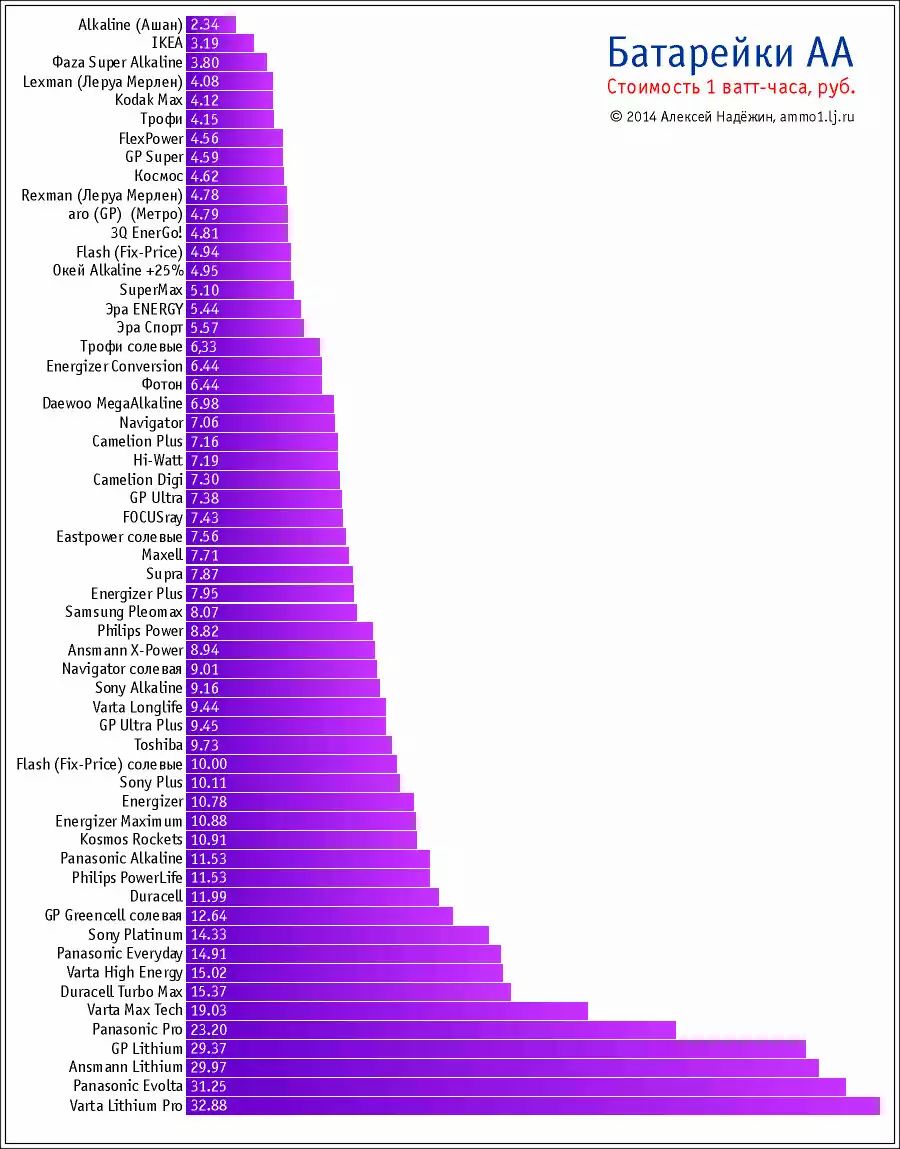
As you can see, Auchan and Ikea batteries have the best price / quality ratio. In other cases, it is worth buying the cheapest alkaline batteries.
AAA batteries
All AAA batteries were discharged with a constant current of 200 mA. Some types of batteries passed the second test - a discharge with a current of 1000 mA in the "constant resistance" mode (the current decreased as the discharge progressed). This mode is used to emulate the operation of batteries in a flashlight.

In AAA format, Duracell Turbo Max turned out to be far from the best alkaline battery. Many cheap batteries (eg Ikea, Navigator, aro, FlexPower) had a larger capacity.
Grand testing of AA and AAA batteries
During this study, Alexey tested 198 batteries.Batteries with a capacity of more than 1500 mAh were charged with a current of 700-800 mA, batteries of a smaller capacity with a current of 500-600 mA. Accordingly, when discharging, batteries with a capacity above 1500 mAh were discharged with currents of 500 mA and 2500 mA, and batteries with a smaller capacity - with currents of 200 mA and 1000 mA.
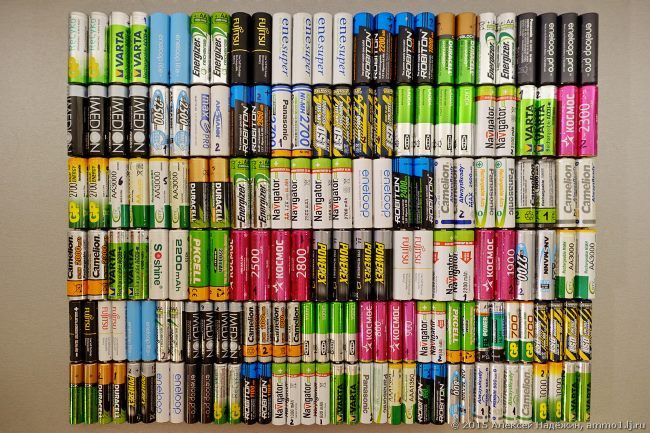
The first test is a capacity test, from which it just follows that the maximum battery capacity is2550 mAh, no matter what marketers write on the package.

For AAA format, this figure is 1100mAh. The most interesting thing is that more than half of all tested batteries are made using LSD technology (Low Self-Discharge - literally, low self-discharge). Therefore, these batteries are sold already charged. Moreover, according to more late Alexey’s research, for 7 months of lying on the shelf, Fujitsu 2550 LSD and Panasonic Eneloop Pro and updated Ikea Ladda batteries behave best (it is interesting that all three brands are, in fact, made at the same factory). Thus, for 7 months of “idle” batteries lost only about 10-15% of their capacity.
Now, as for the prices. Unlike batteries, where the price per piece is significantly lower, the condition is already starting to work for batteries, according to which the price in foreign online stores can be one and a half to two times cheaper than in Russian ones.
But even in this case, the updated Ikea Ladda 2450, which is an almost complete copy of the famous Panasonic Eneloop (they differ only in fewer charge / discharge cycles), are the cheapest offer. I don’t give any graphs on purpose, because the updated Ikea batteries Alexey tested already after I wrote the main review. Nevertheless, at the moment this is the most affordable and highest quality offer on the market.
If an Ikea store in your city is not available, then Fujitsu 2550 LSD or Panasonic Eneloop are the best buys. Eneloop are usually expensive, but sometimes there are promotions that you can buy on Charger, plus 4 batteries is cheaper than other batteries + charging.
And again, not my text. But very interesting. LiveJournal user under the nickname ammo1 did a good deed - he did a lot of testing of AA and AAA batteries. It turned out that ordinary Duracell and Energizer batteries are no better than less famous counterparts, but are several times more expensive. The most profitable batteries are sold under the Ikea and FlexPower brands (and are sold only in these stores) ... But it's better to let the author speak.
The iMAX B6 was used for testing. Each battery was discharged with a current of 0.2A until it could deliver such a current. To confirm the results, I tested two copies of some batteries. My experiments took almost two months, because it took about ten hours to test each battery. All results are in the table.

Measured battery capacity in milliamp-hours. The voltage was measured on the battery two minutes after the start of the test. After the battery "died" it was left for a while (usually half an hour) and the test was carried out again, while it gave off some more energy - "Capacity 2". The cost of one ampere-hour is indicated in the last column.
The results are more visible in the diagram.
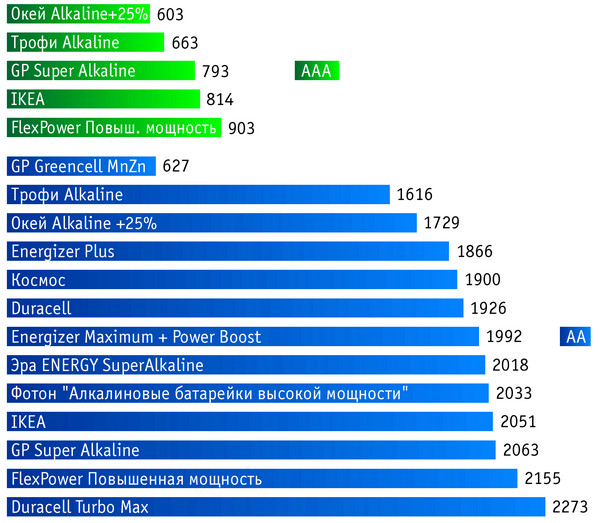
The plate, sorted by the cost of an ampere-hour, shows which batteries are the most profitable.
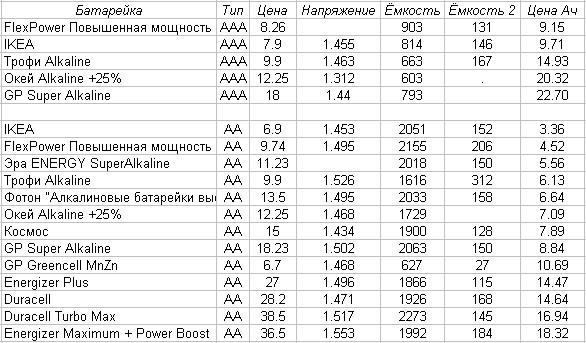
Conclusions:
1. It is pointless to buy ordinary Duracell and Energizer batteries. They are nothing better than batteries which are 2-4 times cheaper.
2. Duracell Turbo Max for 38 rubles a piece of course good batteries, but not as much as they ask for.
3. The capacity of salt batteries is three times less than that of the cheapest alkaline (alkaline).
4. Trophy, Okay - not very good batteries.
5. Duracell is better than Energizer. :)
6. GP, Photon, Era, Cosmos - good batteries, the difference in capacity is less than 10%.
7. The most profitable batteries are Ikea and FlexPower, but they are sold only in Ikea and F-center stores, respectively.
8. The capacity of AAA batteries is almost three times less than that of AA.
9. Perhaps under certain conditions (for example, when discharging with high currents), expensive Duracell batteries can be more efficient than when discharging with an average current, but their capacity is unlikely to be as higher than the same Ikea as their price is higher (5.5 once).
Here's a quick question: what brands of batteries can you name offhand? Many will surely remember DURACELL, ENERGIZER, GP - those brands that often appear in TV advertising. BUTwhat kind of batteries will you buy? Almost certainly - these are the brands that are well-known and well known thanks to advertising. That is, the most expensive. I think it's not a secret for anyone that manufacturers usually include advertising costs in the price of their products ... Now there are a huge number of brands on the battery market that claim increased performance and reliability on the packaging. But is the difference between all kinds of samples really so great? Is it reasonable to overpay for what is most advertised? It was this question that led us to the idea of a group test of the most popular battery sizes.
Text: Alexey SOROKIN.
A comparative test of batteries was carried out in the testing laboratory of electrical products "REGIONTEST" of the Ivanovo State University of Chemical Technology.
Likbez before the start
In order to understand the variety of brands on the market and conduct a correct comparison of batteries in terms of efficiency and performance, it is necessary to choose the right assortment for test tests.
First, it must be the same size batteries. We chose the two most popular formats for testing - AA (LR6, "finger") and AAA (LR03, "little finger").
Secondly, it must be the batteries of one chemical composition. Most of the batteries on the market can be globally divided into two main categories: alkaline batteries (ALKALINE) and saline batteries (ZINC).
Salt batteries are produced using outdated technology. True, despite the "retirement age", they are still sold, they cost no more than 10 rubles apiece. However, salt springs have significantly worse parameters than alkaline ones. They are practically useless in the cold, have a lower capacity and are less able to withstand the impulse and dynamic loads of modern gadgets. They, as a rule, are completed with remote controls, simple toys, wall clocks and other undemanding devices with low energy consumption.
Alkaline batteries have become the basis of modern consumption of batteries (more than 70 percent in pieces). This type of portable power source is the most efficient in any device. Therefore, in today's test, we will only compare alkaline batteries from different manufacturers.
And, thirdly, it must be batteries of similar series or the same purpose. This condition is explained by the fact that in the assortment of most popular brands, the alkaline group is also divided: into the so-called ultra-alkaline batteries (their formula is modified for impulse energy consumption) and standard series batteries for universal use. Some manufacturers provide separate group an economical series of alkaline batteries, most suitable for devices with low energy consumption - as a more modern alternative to salt cells.
So, we finally clarify the conditions for testing alkaline batteries: for greater objectivity, we have chosen standard universal series from various manufacturers.
Comparison Test Participants
The following brands of alkaline batteries participate in our group test:
GP Super Alkaline battery
ENERGIZER Alkaline power
DURACELL (alkaline)
TROPHY Alkaline
Of course, when purchasing, we paid attention to the expiration date of the batteries. Test samples were chosen so that the expiration date was until 2021. Thus, there were no batteries that ran down during storage in our test.
A few words about packaging: GP, ENERGIZER and KODAK are packed in a plastic blister. The rest of the batteries are dressed exclusively in cardboard. Note that fully cardboard packaging is more expensive than plastic, it is more environmentally friendly in production and also easier to open. Therefore, cardboard packaging is a plus for the manufacturer.
All batteries, participants of the test, were purchased in two large retail chains of a similar trade format, which guarantees the price comparability of batteries.
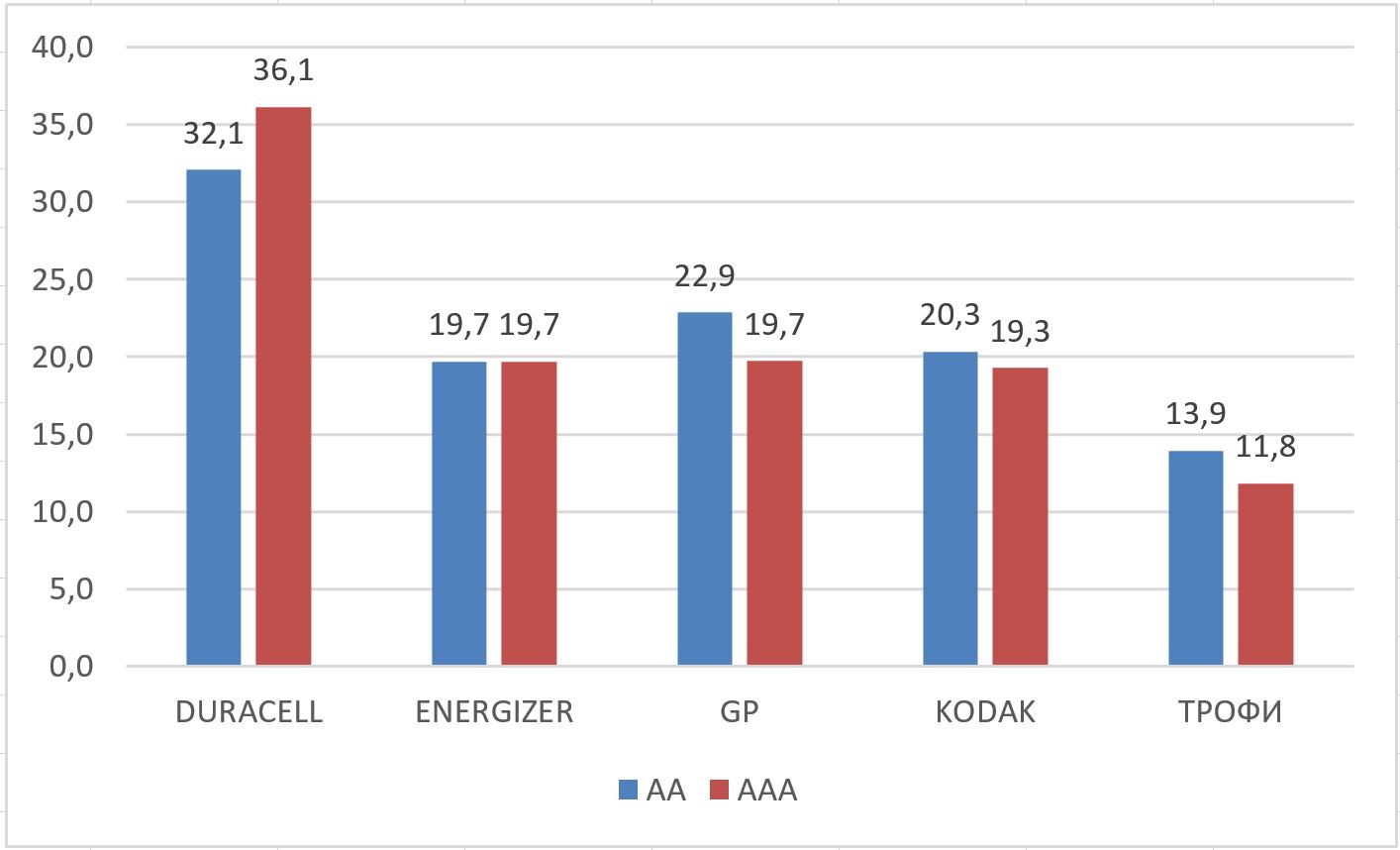
The price is indicated in rubles for one battery.
Interestingly, for all brands except DURACELL, AAA batteries cost less or at least as much as AA batteries. But DURACELL AA batteries are much cheaper (they were bought in one store.
All brands obviously fall into three groups:
expensive - DURACELL,
TROFI batteries were in the position of the brand of the first price.
Let's see if all batteries justify their price and how does a higher price affect their efficiency?
Test Methodology
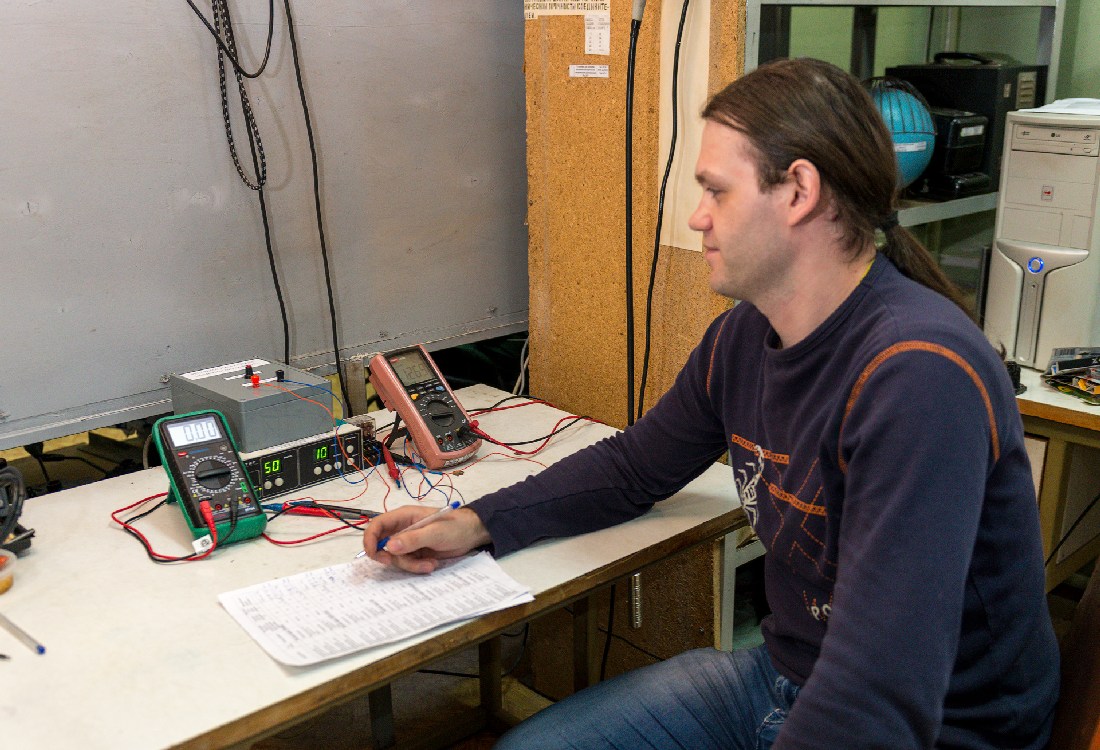
Test engineer Sergey Barinov starts testing
During the first test, the laboratory engineers checked how quickly the batteries drained during continuous discharging. Such a test simulates the operation of, for example, a powerful flashlight or a radio-controlled car, that is, any device that intensively and continuously discharges batteries.
In the test bench circuit, the key element is a 1 ohm resistor, which provided the test samples with a constant load. To control the decreasing voltage in the battery, a voltmeter was connected to it through a resistor, which recorded the residual energy. The test ended when the battery voltage dropped to 0.9 volts.
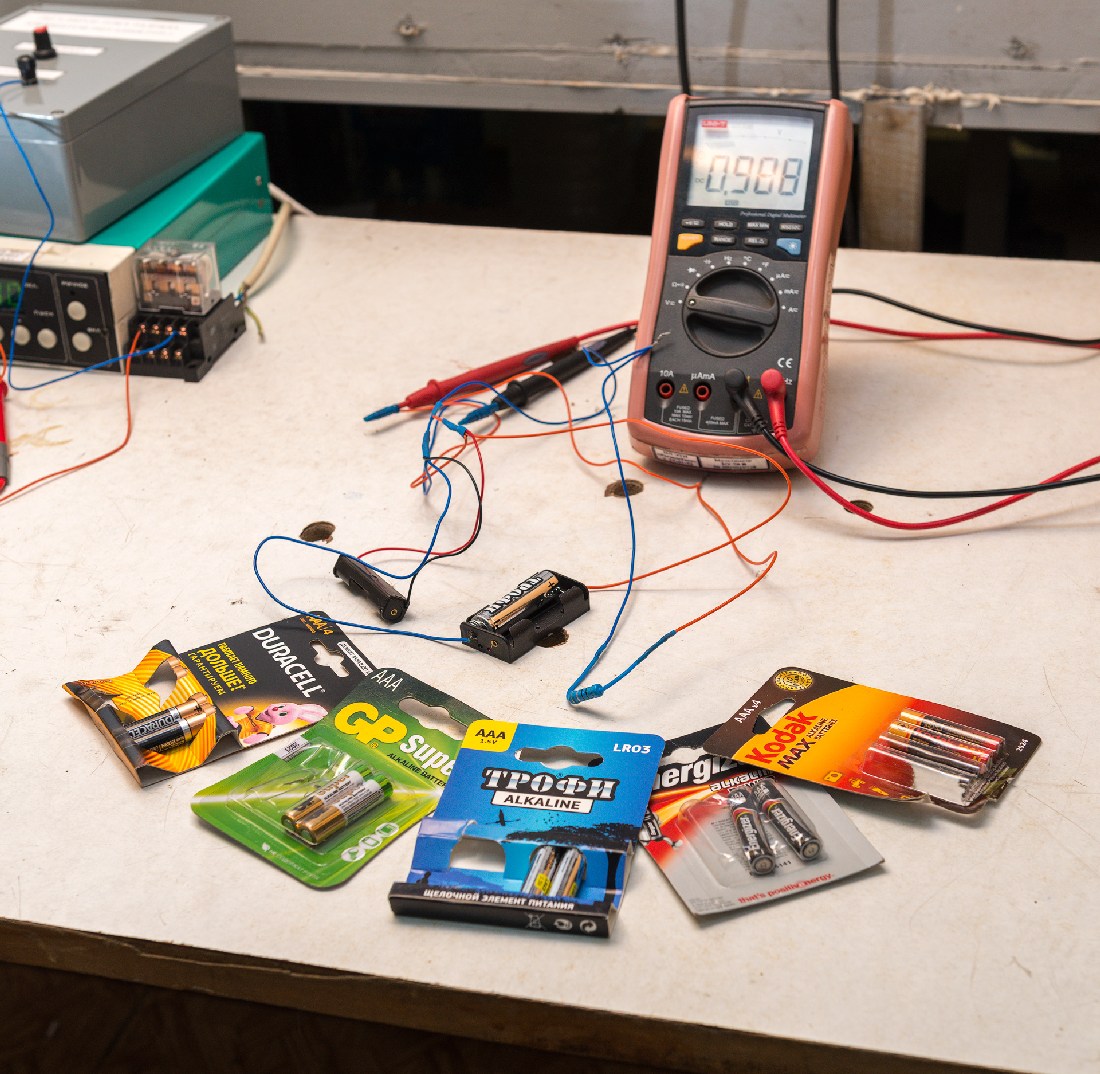
Test participants will have to go through two trials.
The second test subjected the batteries to a pulse discharge, which mimics the operation of devices such as a digital camera with a flash or any other gadget that is characterized by a powerful but short-term discharge.
The test setup for the second test turned out to be more complex: it included the battery itself, a voltmeter showing the residual voltage, a discharge current regulator that maintains D.C. due to floating resistance, an ammeter that controls the current at the level of 1000 mA, and a device with cyclic on-off of the entire circuit. The battery was loaded for 10 seconds, after which the load was turned off for 50 seconds, giving the batteries time to recover somewhat.
As in the first test, the test is considered complete when the battery voltage drops to 0.9 volts.
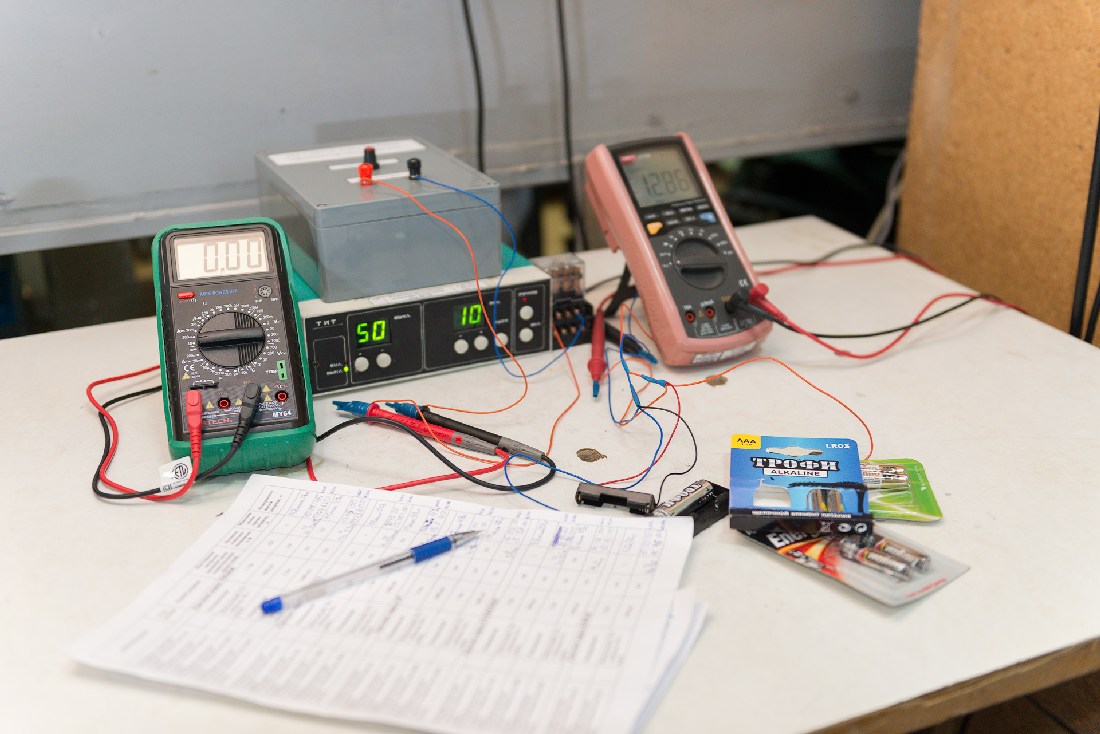
The need for two tests is due to the fact that different batteries can behave completely differently under different discharge options. Batteries are like runners - among them there are marathon runners, and there are also sprinters who are not rivals to each other.
Test number 1. Continuous discharge. AA batteries.
Let's see how the batteries performed in the first test. The Kodak “fingers” worked the longest with a result of 0.9 hours. The second place is shared by GP and TROPHY - with a result of 0.8 hours. The popular brand Duracell was in the penultimate place with a result of 0.72 hours. This is 23 percent less than the time of the test leader. The worst result was shown by Energizer brand batteries, having worked only 0.64 hours. Interesting fact: The difference between the ratings of different brands in this test is almost always 0.1.
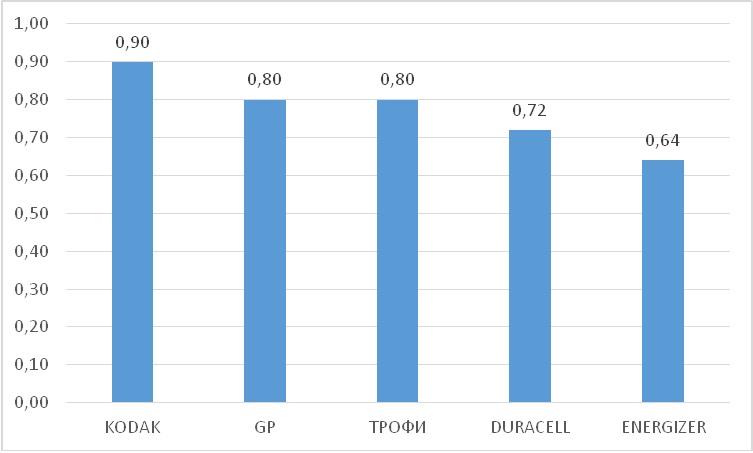
Absolute operating time of AA batteries under continuous load
Test number 2. impulse discharge. AA batteries.
In the pulse version of the discharge, the places were distributed quite differently. Having taken revenge for the defeat in the first test, DURACELL takes the lead, having worked for 4.72 hours. A slightly shorter time - 4.43 hours, was shown by KODAK batteries. The GPs performed 0.5 hours worse, taking third place. This is where the separation group ends, the rest of the batteries showed noticeably worse results. TROPHY worked 3.66 hours, and ENERGIZER 3.58.
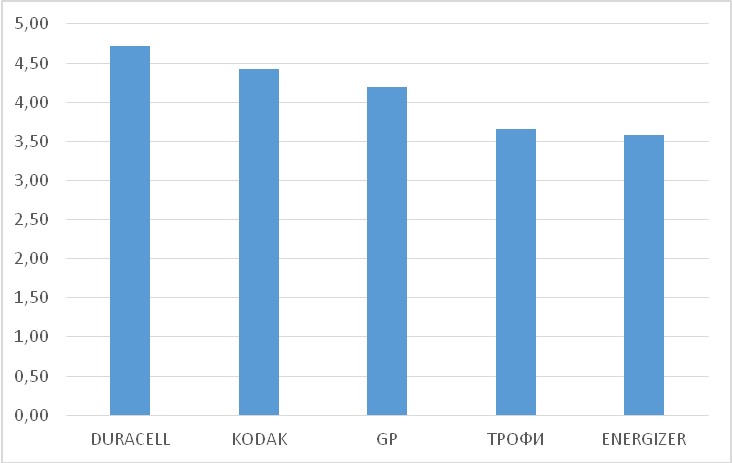
Absolute operating time of AA batteries under impulse load
Such are the dry and inexorable results of the measurement tests. From the point of view of absolute operating time, KODAK batteries look the most advantageous - they lasted the longest with continuous discharge and showed more than a decent result with pulsed discharge.
On the other hand, if you clearly know that you will use batteries in high-tech devices with periodic peak loads, then the best option would be DURACELL batteries that lasted 0.3 hours more in the test than the nearest competitor.
Price and quality of AA batteries
Absolute working time cannot be the only criterion when choosing any product. There are situations when the confidence in the maximum result is worth overpaying for it. But our tests have shown that the efficiency of batteries does not depend on their cost. And if we try to digitize efficiency, let's remember such a concept as price / quality ratio. In the case of batteries, this will be the unit cost, that is, the cost per unit of time - one hour of operation. Obviously, the lower the unit cost, the more profitable your purchase.
After evaluating the unit cost of all test batteries, we can come to an interesting conclusion: in both versions of the test - continuous and pulsed, the distribution of places by brand turned out to be the same. However, there are some subtleties associated with the absolute operating time, which cannot be ignored.
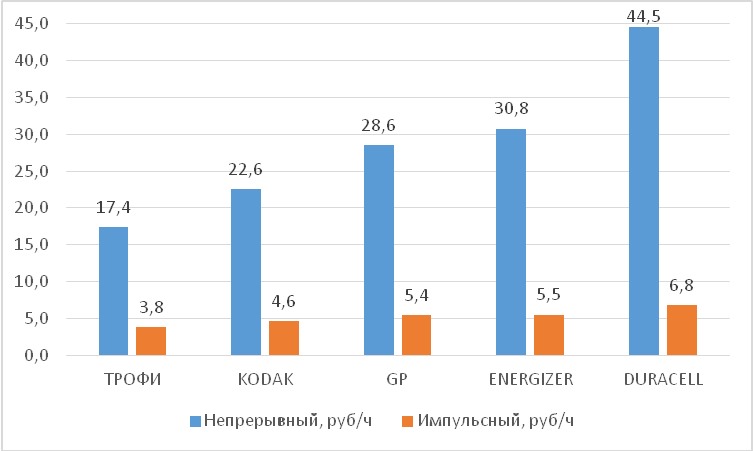
The cost of 1 hour of operation of AA batteries under continuous and pulsed load
DURACELL turned out to be the most uneconomical in the continuous test: their unit cost is 1.5 times higher than that of the closest competitors GP and ENERGIZER, and the absolute operating time is in the penultimate place.
ENERGIZER batteries were not the most profitable either. Showing the lowest duration of work under continuous load, they also have a mediocre price / quality ratio.
But KODAK batteries in this test look pretty good. Having worked the longest in the continuous discharge mode, they have an attractive price / quality ratio - 22.6 rubles / hour. If your priority is absolute battery life at a reasonable price, then KODAK batteries are a good choice.
AA TROPHY batteries became the leader in terms of "price / quality" ratio under continuous load. True, in terms of absolute operating time they are not the best, but they turned out to be 30 percent more profitable than GP batteries, 70 percent more profitable than ENERGIZER and more than 150 percent more profitable than DURACELL. It is easy to calculate that for the price of one DURACELL battery you can buy 2.5 TROPHY batteries and for the same money your flashlight will shine 3 times longer ...
With a pulsed discharge option, TROFI batteries unexpectedly came out on top. The cost of an hour of their work is almost two times less than that of the sales leader DURACELL, the closest pursuer TROPHY is ahead in terms of efficiency by more than 21 percent.
Batteries KODAK in the second test show themselves to be a solid average with a plus. They showed a fairly high duration of work and good efficiency.
When comparing GP and ENERGIZER, which are almost identical in unit cost, it is better to give preference to GP batteries, since their absolute operating time is much higher than ENERGIZER.
But the situation with DURACELL batteries is not unambiguous. Despite the highest cost per hour of operation, it was DURACELL batteries that lasted the longest under impulse load. For good money, you can’t even last so long! If you want the best, pay more. Here, this statement works perfectly.
Conclusion on AA batteries
DURACELL is one of the best options for digital cameras and other devices with a pulsed load, but on the condition that you do not care about the price at all. But for work with a constant discharge - in flashlights or radio machines, DURACELL is not the best choice.
KODAK is the best choice for devices with uniform power consumption. Children's toys with batteries, flashlights, etc. will be very happy with these batteries. They can also be recommended for devices with pulsed energy consumption, especially since the batteries of this brand have a decent level of efficiency.
GP is a solid middling. They showed themselves well in both tests, they have an acceptable price / operating time ratio, which allows us to recommend these batteries for all types of devices. Of course, they will not be the longest-playing and most profitable, but they will be just a workhorse for your devices.
ENERGIZER - unfortunately, the batteries of this brand did not perform well. The worst results in both tests and the high cost of an hour of work - that's all we can say about them.
TROPHY — the brand showed the best price/work time ratio among all test participants and a confident run time. The cost-effectiveness of the batteries of this brand suggests an interesting idea: isn’t it better to buy two cheaper ones instead of one expensive one, but at the same time win almost three times in the supply of electricity?
AAA batteries
If someone thinks that the test results for AAA batteries will copy the results of tests for AA batteries, then this is not so: the alignment of forces turned out to be completely different and more unexpected than for AA batteries.
Test number 1. Continuous discharge. AAA batteries.
For AAA batteries, continuous discharge time is usually more important than for their larger brothers. Judge for yourself, the best among AAA batteries worked 3.5 times less than the AA size finger champion.
The leaders in this test were TROFI brand batteries, which worked for 0.26 hours, leaving more famous brands behind. Looking at the chart, you can see that a group of leaders has formed, which, in addition to TROPHY, also includes DURACELL with a result of 0.23 hours and GP with 0.20 hours. Following are two brands that far outperform the leaders: ENERGIZER and, surprisingly, KODAK. The latter, let me remind you, were the best in the continuous version of the discharge of finger batteries.

Absolute AAA battery life under continuous load
Test number 2. impulse discharge. AAA batteries.
But the results of the test for pulsed discharge are generally similar to the results of tests for AA batteries, but with one big “BUT”: KODAK batteries again ended up in last place, moreover, with a decent lag behind the closest pursuer - ENERGIZER.
The test leader was DURACELL batteries, which were the only ones that worked more than an hour. In second place were GPs with 0.93 hours. The top three is closed by the leaders of the continuous discharge test - TROFI, which showed 0.88 hours. Pay attention to the fairly obvious gap between the top three and the rest of the brands.
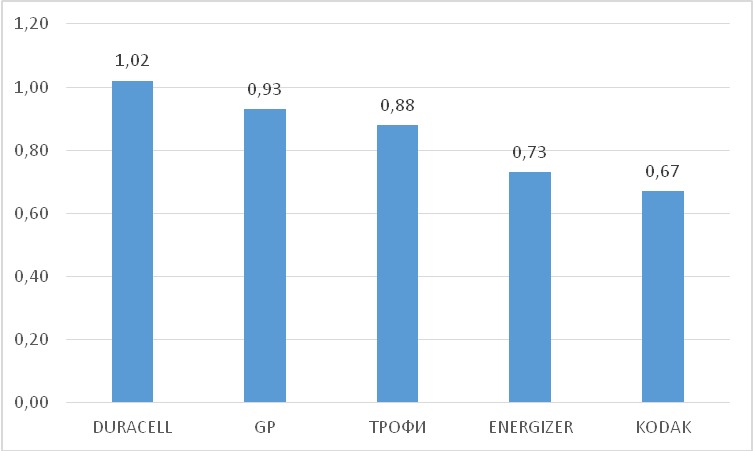
Absolute operating time of AAA batteries under impulse load
Price and quality of AAA batteries
Calculating the cost of an hour of AAA batteries, we also got interesting results.
DURACELL batteries turned out to be the most disadvantageous. Not only did they show the highest cost per hour of work, but in the AAA format they could not become the best in terms of absolute duration of work. So, in this particular situation, overpaying for abundant advertising and a promoted brand does not make any sense at all.
KODAK batteries have shown the worst run time, and although their cost per hour is more reasonable than that of DURACELL, this brand's economy in general is not high. And even lower than that of ENERGIZER batteries, which are also highly promoted by advertising.
The GP brand once again proved to be a solid mid-ranger with a 5-/4+ rating. Yes, they are more profitable than ENERGIZER, KODAK, and even more so DURACEL. However, they are 2 times more expensive than TROPHY batteries.
The most attractive in terms of price-time ratio in the case of continuous load are TROFI batteries, which not only have the lowest cost per hour of operation, but also last the longest. Therefore, TROPHY batteries can be recommended for any devices - uniform and pulsed energy consumption, regardless of what is your priority - saving or duration of work.
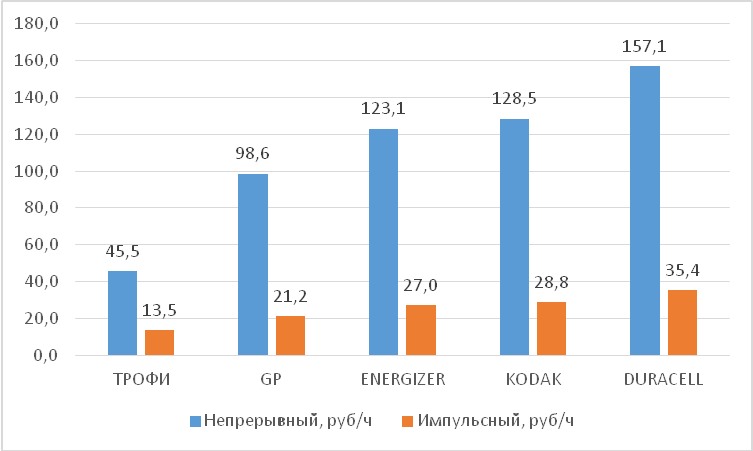
The cost of 1 hour of operation of AAA batteries under continuous and pulsed load
The alignment of forces in the test with pulsed discharge remains similar. Taking into account the absolute indicators, the following conclusions can be drawn. TROPHY, although this time they did not show the best absolute time of work, remained the most economical, moreover, with a margin of 60 percent from the nearest pursuer. It just seems like you can't save much on batteries. When the difference in their cost is so noticeable, an amount that is not superfluous in a crisis will accumulate over the year ...
GP batteries in AAA size look noticeably more interesting than in AA format. In terms of the cost of an hour of work, they are the second number in the final table and are slightly inferior to the leader in terms of the absolute time of work. So AAA GP batteries can also be recommended as an acceptable option for devices with episodic, but peak loads.
ENERGIZER and KODAK turned out to be the least attractive AAA batteries in the impulse test, both in terms of operating time and unit cost.
Conclusion on AAA batteries.
Summing up the results of the test, the following recommendations can be made:
TROPHY - we recommend that you take a closer look at the batteries of this brand. They not only showed decent operating time, especially in the test with a uniform load, where they became the best, they are also at least 60 percent more profitable than their competitors, and in some cases even 3 times more profitable.
DURACELL revealed best time work in pulse discharge mode and a good duration of work (2nd place) in uniform load mode. However, the batteries of this brand are the most expensive, there is the highest cost of an hour of work, which can differ from competitors at times.
GP - If you don't need 20 percent more battery life for an extra 80 percent of the price, then this is definitely the brand for you. Moreover, it does not matter at all in which device you are going to use it.
ENERGIZER - unfortunately, did not surprise us with anything, although they showed themselves better than in the tests of AA batteries. These batteries can be recommended for purchase if you have no alternative.
KODAK - among the "little finger" batteries, this brand frankly showed the worst results, both in terms of the absolute duration of work and in terms of the cost of an hour of work.
Test nominations
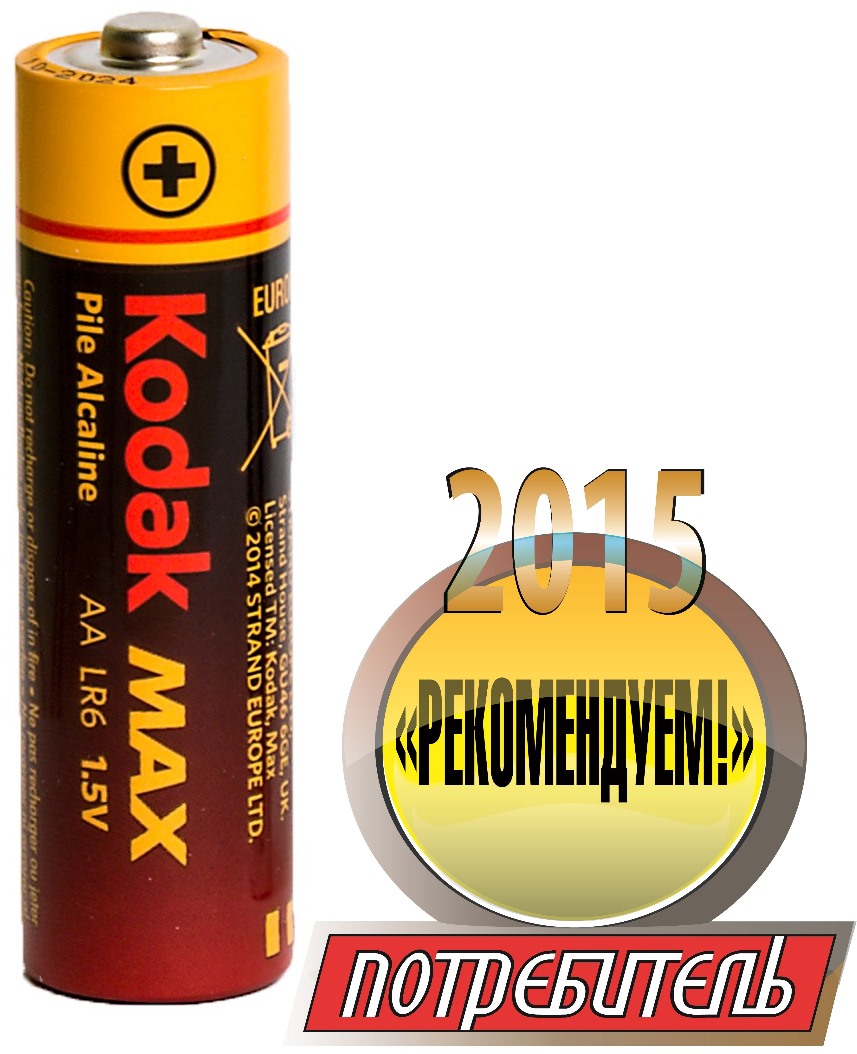
KODAK AA Batteries are the best choice for energy-saving devices. Children's toys with batteries, flashlights, etc. will be very happy with these batteries. They can also be recommended for devices with pulsed power consumption.
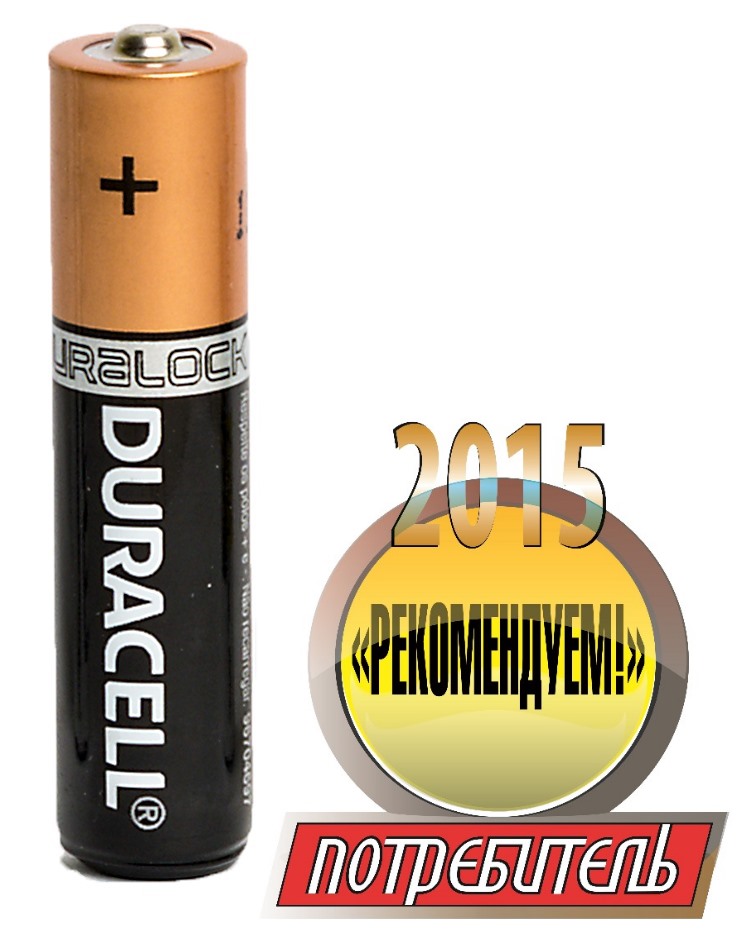
DURACELL AAA batteries showed the best operating time in the pulsed discharge mode and one of the best in the uniform load mode. In addition, DURACELL AA batteries are great for working in digital cameras and other devices with a pulsed load, however, provided that you do not care about their price at all.
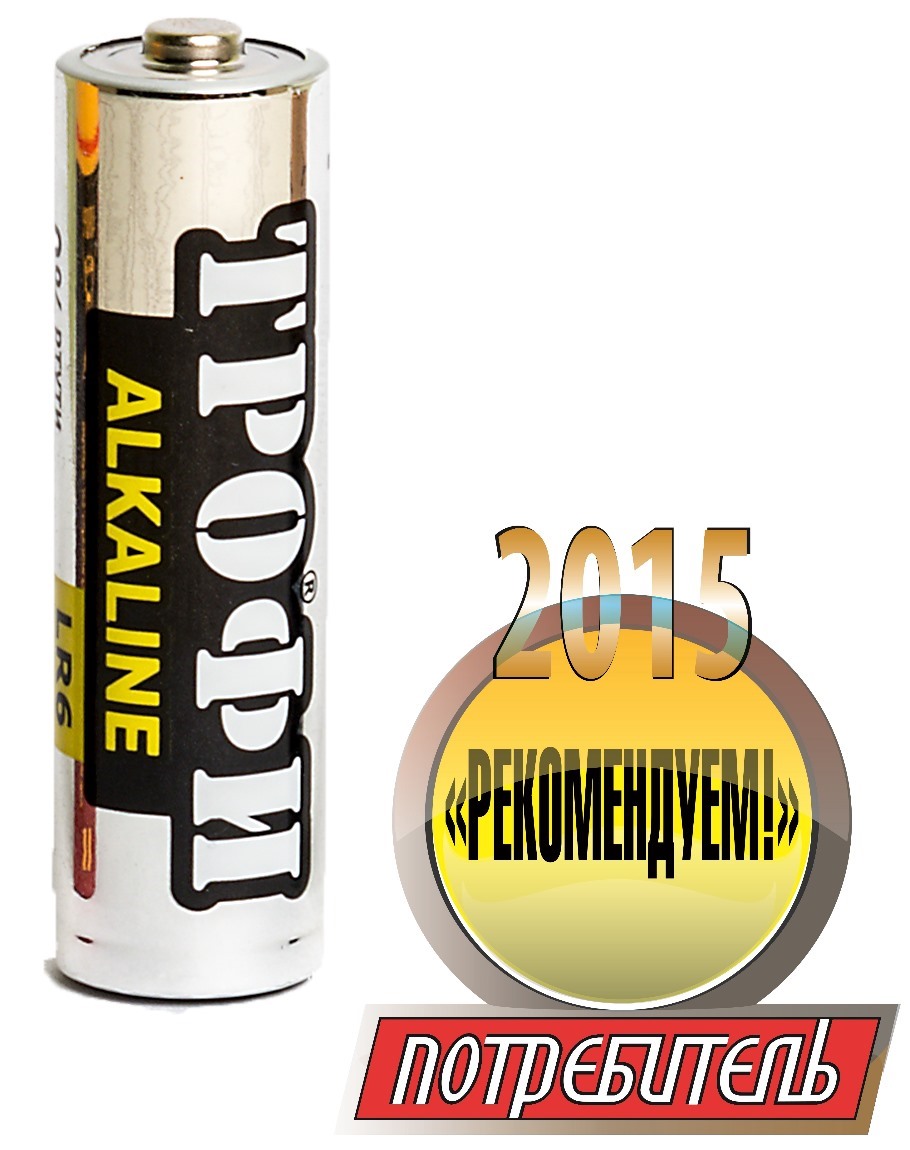
Batteries TROPHY of both sizes - AA and AAA, showed the best price / operating time ratio among all test participants and a confident operating time.
conclusions
The results of the comparative test clearly proved that the statement “more expensive means better” does not always work. And the cost of the brand's advertising campaign is not of particular importance: batteries of a domestic brand, for example, in all tests outperformed such a well-known brand as ENERGIZER, and in some tests - no less famous DURACELL.
The quality of batteries does not depend on their retail prices on the shelves in the store. From the point of view of efficiency and the cost of one hour of work, the TROPHY batteries were the best in both cases. For the rest, look at the test results, compare them with your needs and decide which brand to choose next time.
For each case there is best option. With this conclusion, we move on with our lives.
Every time I buy batteries, I wonder which ones are better. There are many batteries at about the same price, there are cheap batteries that are sold only in certain stores - Ikea, FlexPower, Okay, there are expensive Duracell, Energizer batteries. Are expensive batteries always better than cheap ones?
I have long wanted to compare batteries, and finally I did it.
The iMAX B6 was used for testing. Each battery was discharged with a current of 0.2A until it could deliver such a current. To confirm the results, I tested two copies of some batteries. My experiments took almost two months, because it took about ten hours to test each battery. All results are in the table.

Measured battery capacity in milliamp-hours. The voltage was measured on the battery two minutes after the start of the test. After the battery "died", it was left for a while (usually half an hour) and the test was carried out again, while it gave off some more energy - "Capacity 2". The cost of one ampere-hour is indicated in the last column.
The results are more visible in the diagram.
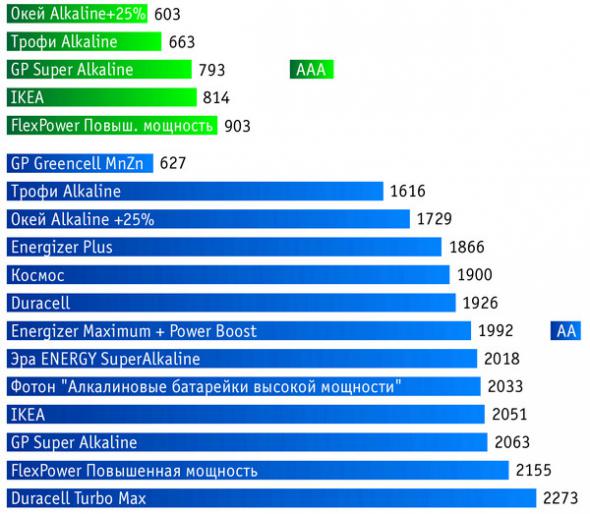
The plate, sorted by the cost of an ampere-hour, shows which batteries are the most profitable

1. It is pointless to buy ordinary Duracell and Energizer batteries. They are no better than batteries, which are 2-4 times cheaper.
2. Duracell Turbo Max for 38 rubles a piece of course good batteries, but not as much as they ask for.
3. The capacity of salt batteries is three times less than that of the cheapest alkaline (alkaline).
4. Trophy, Okay - not very good batteries.
5. Duracell is better than Energizer. :)
6. GP, Photon, Era, Cosmos - good batteries, the difference in capacity is less than 10%.
7. The most profitable batteries are Ikea and FlexPower, but they are sold only in Ikea and F-center stores, respectively.
8. The capacity of AAA batteries is almost three times less than that of AA.
9. Perhaps under certain conditions (for example, when discharging with high currents), expensive Duracell batteries can be more efficient than when discharging with an average current, but it is unlikely that their capacity will be as higher than the same Ikea as their price is higher (5.5 times) .



